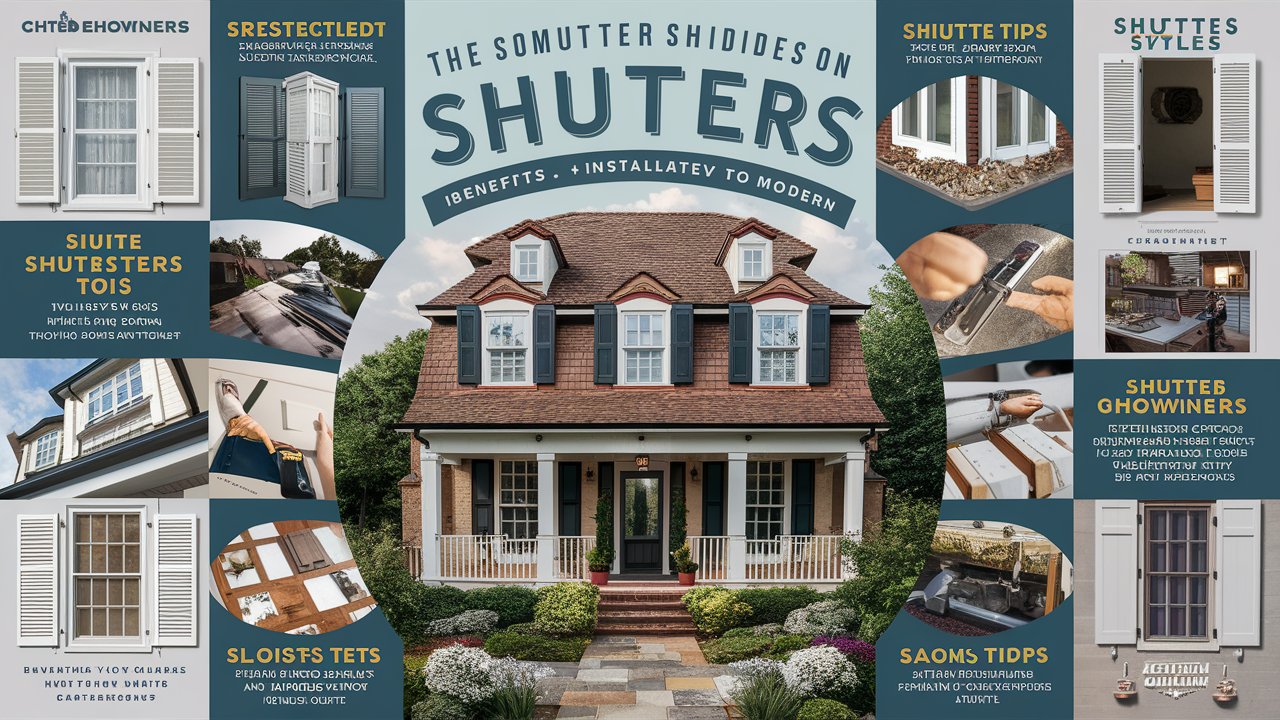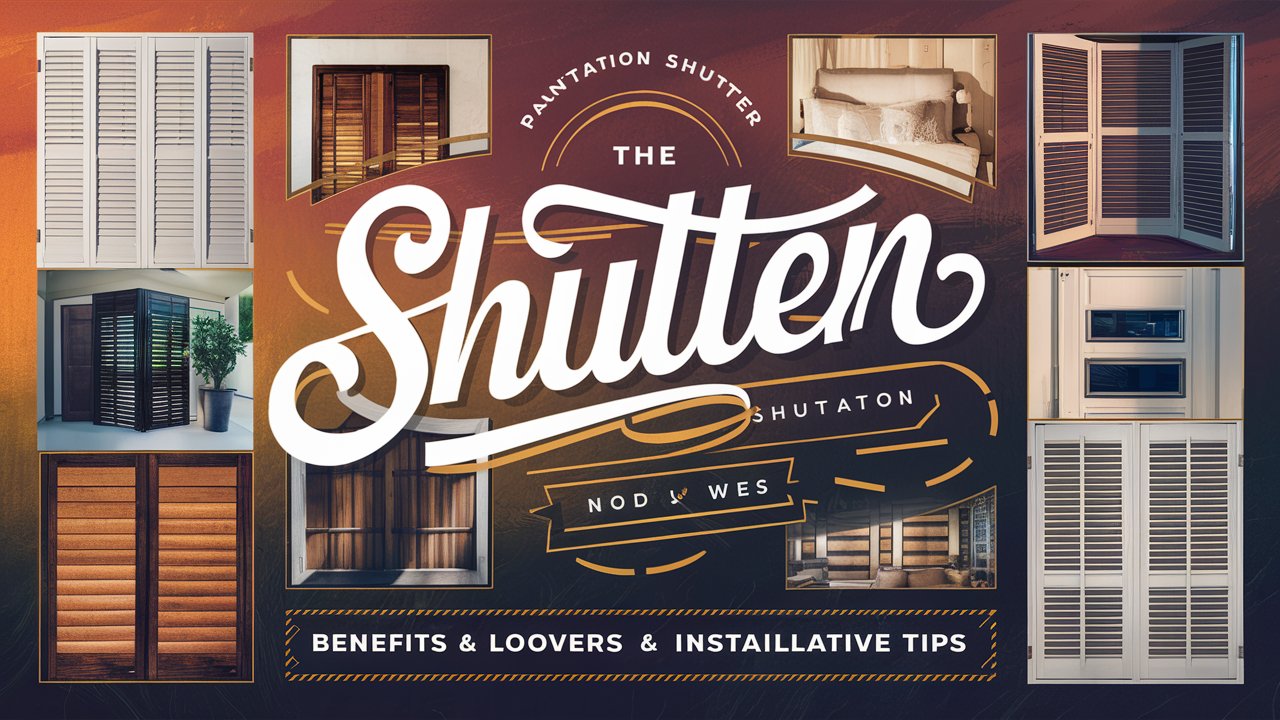Home
The Ultimate Guide to Shutters: Styles, Benefits, and Installation Tips

Shutters are more than just window coverings; they represent a perfect blend of functionality, elegance, and home value. For centuries, shutters have been used to provide privacy, insulation, light control, and timeless style. Whether you’re looking for interior shutters to transform your living space or exterior shutters to add curb appeal, understanding the different types, materials, and installation methods can help you make the best choice.
In this comprehensive guide, we explore everything you need to know about shutters: from their history and design options to their maintenance and benefits.
What Are Shutters?
Shutters are solid and stable window coverings consisting of a frame with horizontal or vertical louvers. These can be fixed or operable, allowing homeowners to adjust airflow, privacy, and natural light. Unlike ordinary blinds or curtains, shutters offer a more durable and stylish solution that can complement any architectural style, from modern minimalism to traditional elegance.
Types of Shutters
1. Interior Shutters
Interior shutters are installed inside the home and are perfect for achieving light control, energy efficiency, and aesthetic charm. Popular types include:
-
Plantation Shutters – Known for their wide louvers, plantation shutters are a favorite choice for living rooms and bedrooms, offering excellent ventilation and light regulation.
-
Café Style Shutters – Covering only the bottom half of windows, café shutters add European flair while preserving outside views.
-
Tier-on-Tier Shutters – Featuring independent top and bottom panels, these shutters provide maximum flexibility for privacy and lighting.
2. Exterior Shutters
Exterior shutters enhance curb appeal and protection for your windows. Common varieties include:
-
Louvered Shutters – Classic and versatile, these provide ventilation while adding elegance to a home’s façade.
-
Raised Panel Shutters – A more traditional look, often paired with colonial-style homes.
-
Board and Batten Shutters – Rustic and charming, ideal for farmhouse or cottage-style properties.
-
Bahama Shutters – Hinged at the top, they offer shade and storm protection, popular in tropical climates.
Materials Used in Shutters
When choosing shutters, material selection is crucial for durability, maintenance, and cost-effectiveness.
-
Wood Shutters – Traditional and luxurious, wood shutters offer timeless elegance but may require regular maintenance.
-
Composite Shutters – Made from engineered materials, these mimic the look of wood but are more resistant to moisture and warping.
-
Vinyl Shutters – Budget-friendly, lightweight, and low maintenance, though less durable than wood or composite.
-
Aluminum Shutters – Strong and weather-resistant, often used for exterior storm protection.
Benefits of Installing Shutters
1. Energy Efficiency
Shutters act as an additional insulation layer, reducing heat loss in winter and keeping interiors cool in summer. This can lead to lower energy bills and improved comfort.
2. Light and Privacy Control
Unlike curtains, shutters allow you to tilt the louvers to achieve the perfect balance of natural light and privacy, without compromising ventilation.
3. Aesthetic Appeal
Shutters add a clean, sophisticated look to any space. Interior shutters elevate the design of living areas, while exterior shutters provide curb appeal and architectural harmony.
4. Increased Home Value
Real estate experts agree that well-designed shutters can boost property value due to their durability, timeless appeal, and functional benefits.
5. Durability
Shutters are built to last, especially when made from quality materials. Unlike blinds or drapes, they don’t wear out easily and require minimal replacement.

How to Choose the Right Shutters for Your Home
When selecting shutters, consider:
-
Style of Your Home – Match the shutters to your interior or exterior architectural design.
-
Purpose – Are they mainly for aesthetics, energy efficiency, or storm protection?
-
Material Preference – Choose based on climate, budget, and maintenance needs.
-
Color Options – Neutral tones blend seamlessly, while bold colors make a statement.
Shutter Installation: DIY vs. Professional
DIY Installation
If you are handy with tools, DIY shutter installation can save costs. It requires precise measurements and basic carpentry skills.
Professional Installation
For a perfect fit and long-term performance, hiring professionals ensures accuracy, customization, and expert finishing. Many companies also offer warranties on installation.
Maintenance Tips for Shutters
-
Dust Regularly – Use a microfiber cloth or vacuum with a brush attachment.
-
Avoid Excess Moisture – Especially for wood shutters, keep them dry to prevent warping.
-
Check Hinges and Hardware – Tighten screws and oil hinges when necessary.
-
Repaint or Refinish – For exterior wood shutters, periodic refinishing preserves their look and protection.
Shutters vs. Blinds: Which is Better?
While blinds are a cheaper option, shutters are more durable, energy-efficient, and stylish. Shutters also add to a property’s resale value, whereas blinds are often seen as temporary solutions.
Conclusion
Shutters are a smart investment for any homeowner seeking a balance of style, privacy, energy efficiency, and durability. With a wide range of designs, materials, and customization options, shutters offer timeless beauty and functional benefits that few other window treatments can match. Whether you choose interior plantation shutters or exterior board and batten shutters, the right choice will elevate both the look and value of your property.
Frequently Asked Questions (FAQ)
Q1: Are shutters worth the investment?
Yes, shutters increase energy efficiency, enhance privacy, and boost home value, making them an excellent long-term investment.
Q2: Can shutters be installed on all types of windows?
Absolutely. Shutters can be custom-made to fit any window size or shape, including arches and bay windows.
Q3: Do shutters require a lot of maintenance?
No, shutters are relatively low-maintenance compared to curtains and blinds. Simple dusting and occasional refinishing are usually enough.
Q4: What are the best shutters for humid climates?
Composite or vinyl shutters are best for high-moisture areas, as they resist warping and damage.
Q5: Can shutters help with noise reduction?
Yes, shutters provide an added barrier that helps reduce outside noise, making them ideal for urban settings.

-

 Technology1 month ago
Technology1 month agoThe Ultimate Guide to Trucofax: Features, Benefits, and How It Works
-

 Entertainment1 month ago
Entertainment1 month agoHitaar – Meaning, Significance, and Complete Guide
-

 Trends1 month ago
Trends1 month ago“Coomer SU: Understanding the Phenomenon and Its Impact”
-

 Business1 month ago
Business1 month agoTroozer com – Everything You Need to Know About the Platform
-

 Technology1 month ago
Technology1 month ago“How to Redeem Robux on iRobux.com – Step-by-Step Guide (2024)”
-

 Technology1 month ago
Technology1 month agoHMS Photovoltaik: The Future of Solar Energy Efficiency & Innovation
-

 News1 month ago
News1 month agoUnited Airlines Flight UA770 Emergency Diversion: A Detailed Report
-

 News1 month ago
News1 month agoUnited Airlines Flight UA770 Emergency Diversion: A Full Breakdown